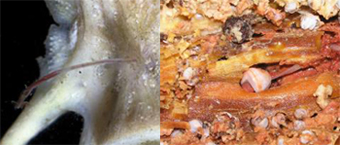111- bone,shipworm.jpg

Left: a boneworm on a fish bone. Credit: Greg Rouse. Right: shipworms burrowed into a piece of wood. Credit: Christina Bienhold, MPI for Marine Microbiology.
For almost any object in the sea, there’s a creature who will feed on it – even if it’s a whale skeleton or a shipwreck. Though not related to one another, boneworms and shipworms share the remarkable ability to locate their meals in the vast ocean. Boneworms consume the bones of mammals, fish, reptiles and other animals, while shipworms – actually a type of mollusk – use their tiny shells to burrow into the wood of wrecked ships, trees adrift, or other wooden structures in the sea. Despite having neither stomachs nor mouths, both boneworms and shipworms have symbiotic bacteria in their gut that release nutrients from the bones or wood which these “worms” absorb as food.
Though they are found throughout most of the world’s oceans, a recent experiment showed that they don’t live everywhere. Researchers placed whale bones and wooden planks at two sites near the west Antarctic Peninsula and then hauled them up a little more than a year later. Boneworms, it turns out, were plentiful; some bones had as many as 200 worms in an area the size of a deck of cards. But the wood was untouched; shipworms were nowhere to be found.
Scientists suspect the boneworms were there because whales have historically frequented waters off the Antarctic Peninsula, providing plenty of meals for boneworms. However, trees haven’t grown that far south for more than 30 million years, offering little reason for shipworms to move in. But that also means that shipwrecks in the Southern Ocean, such as that of Antarctic explorer Ernest Shackleton, may survive intact at the bottom of the sea, waiting to be found.


